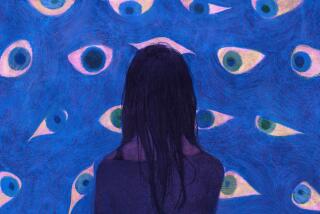Some New Weapons Against the Diseases That Steal Vision
- Share via
When she was 7 years old, Laura Brassard became a habitue of the night. Daylight had become unbearable. In school, she would squint at the blackboard from behind dark, wraparound sunglasses. Even the faint glow of street lights made her eyes burn.
What cast a gloom over her world for the next 10 years was a rare eye disease, Stevens Johnson syndrome. Triggered by an allergy to common medications, the disease produces sores inside and outside the body that eventually heal but leave lasting vision damage.
Not only do the eyes become exquisitely sensitive to light, but the eyelids become so rough and scaly that a mere blink, even the darting eye movements of dream-filled sleep, is like sandpaper rubbing over the cornea, the transparent tissue covering the eyeball. Because the damaged cornea no longer focuses light correctly, patients often become legally blind, able to discern only big, blurry forms.
“They live a life that has been described to me as living like a vampire--only going out at night,” says Dr. Perry Rosenthal, a Harvard University School of Medicine ophthalmologist and president of the Boston Foundation for Sight.
But all that has started to change. In 1994, Rosenthal received approval from the U.S. Food and Drug Administration for a novel lens that has given back sight to Brassard and other patients with corneal damage. Rosenthal’s invention is just one of several visionary ideas these days in sight restoration. As technology produces materials that can coexist with the body and scientists better understand the mechanisms of sight and blindness, researchers are developing treatments for acquired blindness that could not have been imagined even 10 years ago.
The Boston scleral lens, as Rosenthal calls it, looks like an oversized contact lens. About the size of a quarter, it arches over the cornea and rests on the relatively insensitive sclera, the white tissue of the eye. The space between the lens and the cornea is filled with artificial tears--a layer of lubricating fluid that protects the eye, smooths surface irregularities and fulfills the optical duties of the damaged cornea.
The result is that people with corneal disorders and injuries--tens of thousands in the United States alone--might see painlessly again. The lenses can replace corneal transplant surgery--an option that is not foolproof and is prohibitively expensive in developing countries, where blinding corneal diseases are common. For patients like Brassard, whose underlying medical conditions make transplant surgery futile, the lenses are the only way to restore sight.
If the scleral lens has transformed lives in the here and now, genetic research is looking for dramatic cures during the next decade. From pediatric eye-muscle disorders like strabismus, in which both eyes cannot focus on the same point, to common diseases of adulthood such as glaucoma and cataracts, to the macular degeneration of old age, genes play a significant role.
If researchers find out how genetic mutations alter the eye’s normal functions, they could create tailor-made treatments that would compensate for the changes. These treatments could range from gene therapy to transplanting healthy cells to administering drugs.
Today, two unexpected drugs are being used to treat vision-robbing disorders. One is the botulinum toxin, a purified form of the bacterial toxin that can paralyze and kill if eaten in contaminated food. Patients with conditions such as blepharospasm, muscle contractions that squeeze the eyelids shut, receive injections that weaken the clenched muscles and allow the lids to part.
The second drug is thalidomide, the notorious sedative that, in the late 1950s and early 1960s, caused pregnant women to give birth to babies with missing or stunted limbs. Because it prevents blood vessels from proliferating, thalidomide is being clinically tested at the Massachusetts Eye and Ear Infirmary as a treatment for macular degeneration, in which unchecked vessel growth impairs sight.
Perhaps the most futuristic technology today is the retinal implant pioneered by Dr. Joseph Rizzo at Massachusetts Eye and Ear. This electronic microchip, now being tested in rabbits, sits on the surface of the retina, the nerve layer at the back of the eye that senses light and helps to send images to the brain. The microchip transforms visual data into electric pulses, substituting for the chemical messages of the retina’s rod and cone cells. Theoretically, if the chip received a picture from the outside and converted it into neural messages, it would result in an artificial version of shadow and light that bypasses the damaged eye. But this particular scientific vision is loaded with ifs.
But patients like Brassard have no choice but to rely on miracles. Three years ago, when she was fitted with the Boston scleral lens, her life changed. She could open her dark-brown eyes in daylight without pain and give up her sunglasses.
“I felt invincible,” she says. “I had a newfound confidence.” So much confidence, in fact, that she was chosen to star in her high school’s production of “The Belle of Amherst,” a two-hour solo performance under the spotlights. “It’s a new thing for me to look into people’s eyes,” says Brassard, now a junior at Rhode Island College. “But I can do it, and I will do it.”






